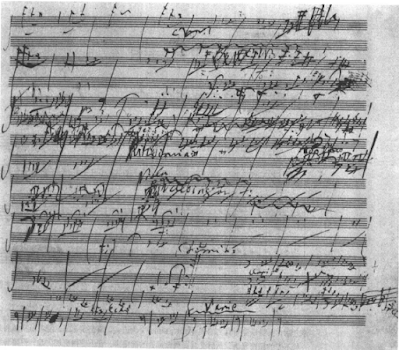CXV. BEETHOVEN, Ludwig van (1770-1827)
and I thought my sketchbooks were hard to read ...
**
A non-musician friend of mine once asked me, "what makes Beethoven so great?"
I replied that I thought his simplicity was covered in complexity. For example, look at the simple harmony which opens the work:
It's all so simple. And yet things get awfully complex after awhile. Near the end of the movement, Beethoven shouts the theme out -- firmly -- in the subdominant (10:38):
Second Movement
Meanwhile, look how peaceful things are down the by the brook (12:40):
At the end of the movement, Beethoven gives us a musical picture of the birds he hears (nightingale [flute]; quail [oboe] and cuckoo [clarinet]:
Happy countryfolk! Note the delicate dance in the unison strings (24:41):
Note how Beethoven paints the scene of the coming storm (30:12).
The celli and basses start off the a threatening tremolo, pianissimo. The second violins play a staccato, bouncy line -- the country folk are still dancing!
But see how the first violins come in with a threatening three-note phrase! The storm is coming!
But see how the first violins come in with a threatening three-note phrase! The storm is coming!
After the storm, notice how Beethoven uses the final two bars to introduce the final movement with a V of V -- that means that he's using a G7 (dominant to C Major) to set up the initial use of that dominant before he settles back into F Major ... magic! (34:09)
End of Fourth/Fifth Movement













No comments:
Post a Comment